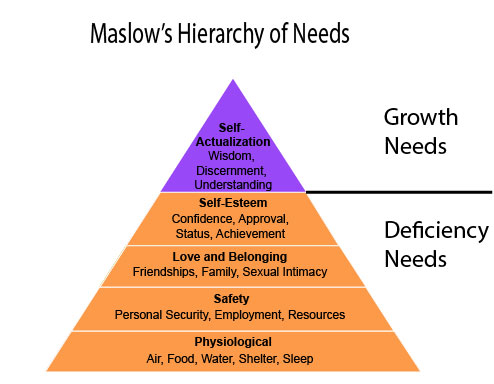The concept of the ego can be traced back to Sigmund Freud in the Psychoanalytic Theory of Personality (1923). Freud described the personality as comprised of three elements: the id, the ego, and the super-ego.
The id represents our primal urges, drives and instincts. The super-ego operates as a moral conscience derived from parental and societal standards and regulations. The ego is the part of our personality that mediates between the urges of the id and the moral high ground of the super-ego.
There have been numerous contributors to Freud’s theory and the development of personality since. Abraham Maslow built upon Freud’s personality theory and titled it Theory of Motivation (1943). Maslow’s theory is based upon a Hierarchy of Needs model. He further details how people are motived to fulfill their needs hierarchically from the most basic to more complex needs.

When a need (Basic, Psychological, or Self-Fulfillment need) has mostly been satisfied, we naturally focus on meeting the next set of needs we have yet to meet.
Many of us teeter between having our Basic needs and Psychological needs met, specifically our Safety needs (personal security and resources), Love and Belonging, and Self-Esteem. We tend to get stuck in these lower to middle ranks of Maslow’s hierarchy. This is also known as our Deficiency Needs.

Being stuck within our Deficiency Needs can partially be attributed to our media, mass marketing, and society. Popular media showcases celebrities with nearly impossible living standards to live up to for the average person. Mass marketing manufacturers unnecessary needs for profit, telling us we are not enough unless we have this product or look a certain way. These false needs become ingrained into the fabric of our society, and at times even become values demonstrated by those close to us, such as our parents, siblings, close friends, bosses or coworkers. Once we can differentiate our actual needs from the manufactured ones, we can develop our sense of self, contributing to completing our Self-Esteem needs. Potentially moving towards fulfilling our Growth Needs.
Self-Actualization Needs are also known as Growth Needs, the top portion of Maslow’s hierarchy. This is the place where we have a desire to grow as a person. Not every person is capable, has the desire to, or will move through the hierarchy in one direction toward the level of self-actualization. Many of us will progress and regress, only to progress again.
Ego and Hierarchy of Needs
Self-actualization needs/Growth Needs are the highest level in Maslow’s hierarchy and refer to realizing a person’s potential, self-fulfillment, seeking personal growth and peak experiences. Maslow (1943) describes this level as the desire to accomplish everything that one can, to become the most that one can be.
When we combine The Theory of Personality (Freud) and The Theory of Motivation (Maslow), the urges of the id decrease as we fulfill our hierarchically needs. In turn, we develop ego strength, thus having a more robust and healthier ego.
Ego strength is when we have the ability to maintain our sense of self and identity in the face of stress, pain, and many of life’s challenges if we can develop healthy coping mechanisms to alleviate or eliminate our suffering.
Post-Traumatic Growth and Ego Strength
Post-traumatic Stress Disorder (PTSD) is classified as an anxiety disorder we develop when we cannot process an event and is difficult to make sense of. These events could range from a single event such as witnessing a crime, going through a natural disaster, finding a partner cheating, or a series of events like being in a neglectful relationship, experiencing a difficult childhood, or workplace bullying.
Post-traumatic Growth (PTG) is when a person faces a major life crisis or situation and gains wisdom, insights, and experiences positive change due to the initial struggle and what occurred. According to the University North Carolina, Department of Psychological Science, Posttraumatic Growth Research Group, there are five (5) areas growth tends to occur in generally:
- Develop a sense of new opportunities and opening up possibilities that were not present before.
- A change in our relationships with an increased connection or compassion for others who suffer.
- Increase sense of one’s own emotional strength and resiliency.
- Greater appreciation for life in general.
- Deepening in spirituality or religious outlook often involving a significant change in one’s belief system.
PTG can attribute to our ego strength development but is similar to being thrown into deep waters and figuring how to swim. Ego Strength can be developed slowly by meeting each of the Hierarchy of Needs levels or can develop rather abruptly through Post-Traumatic Growth.
What is a Highly Developed Healthy Ego?
When we have a highly developed healthy ego, we are confident with who we are. We are respectful of others even without receiving the same respect back. That doesn’t mean we are a doormat, but rather we remain composed and bold in our stance not to be swayed by negative or fearful dispositions.
We can regulate our emotions through life’s challenges. That doesn’t mean we don’t exhibit our feelings. Rather we are skilled and swift in our healing abilities and coping mechanisms that cause no harm to ourselves or others.
Regardless of what happens to us, we don’t take what others do to us personally. The actions people take reflect what is going on in their world at the time, including but not limited to their current values, belief system, priorities, how healed they are, and the actions they choose to take. It really has nothing to do with us, and nor is it personal.
We forgive without receiving apologies and provide compassion for other people’s struggles. Offering forgiveness alleviates us from the burden of hurt and pain. Jesus Christ displayed this when he said, “if anyone slaps you on the right cheek, turn to them and offer the other cheek.” We respond to injury without seeking revenge but accepting our predicament and command nonresistance and pacifism. This is not to say that we have become martyrs for all hurt and scared people, but there are appropriate situations, times, and places.
We love ourselves and others without condition. We separate the actions that people do from who they innately are. Many of us experience toxic shame, like believing we are dumb or useless when we make a mistake or permanently labelling others based on their actions. We all have different motivations for our actions, many of which come from a place of fear. If we have compassion for ourselves and others since we are all generally trying our best with what we know and how healed we are, we become closer to loving ourselves and others unconditionally.



